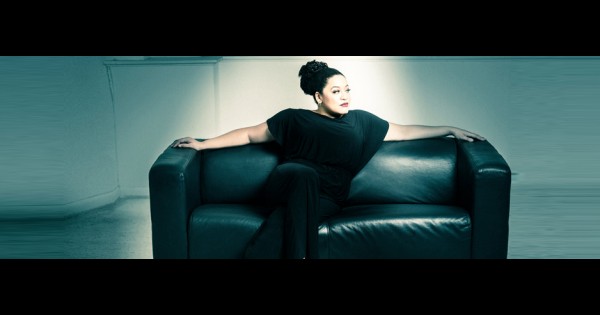SOARING HIGH
Presented in her Washington recital début by Vocal Arts DC, soprano Michelle Bradley sang an impressive recital in The Terrace Theater on Wednesday evening.
by Patrick D. McCoy
With the advent of social media, the musical talents of an artist can be experienced well ahead of a live public performance. However, nothing replaces experiencing the special gift of hearing a new artist in person. Soprano Michelle Bradley‘s appearance at The Kennedy Center certainly went beyond the media hype and proved to be the musical proof in the pudding. Accompanied by the esteemed pianist Ken Noda, Bradley presented a recital of songs by Henri Duparc, Samuel Barber, Giuseppe Verdi and Richard Strauss. Committed to continuing the legacy of Vocal Arts DC founder Gerald Perman, Bradley’s recital was presented as a part of The Gerald Perman Fund for Emerging Artists Recital Series.
Taking the stage in an elegant, sweeping green gown with train, the soprano ‘wowed’ the audience before she sang her first note. There was such a regal presence that was readily felt and certainly gave a nod to the grandeur of the great sopranos of the past. Opening the recital were three songs by Henri Duparc. “L’invitation au voyage” introduced the audience to a voluptuous sounding, full soprano, even from top to bottom. With her exceptional pianist Ken Noda, there was a feeling of musical partnership that was experienced, especially in the diminuendo towards the end, highlighted by the sensitive accompaniment. This feeling continued in the “Chanson triste” as Bradley floated above the rolling musical tide created by the piano. In the final song of the set, “Phidlye” brought the voice into a full crescendo, filling the space with sound.
In 1953, the great soprano Leontyne Price debuted the “Hermit Songs” at the Library of Congress with the composer Samuel Barber at the piano. Though Bradley revealed later in the program that her idol was the great soprano, in retrospect the choice of the Barber songs certainly was a wonderful tribute to the legend. The cycle of songs presented a variety of moods, as well as length. Full of several vignettes, there were a few that truly allowed the voice to display an array of qualities. “Saint Ita’s Vision” showed the soprano’s ability to sing with an elegant sense of vocal balance. With a beautiful spin to the phrase, there was an audible quality that could be visualized as the Infant Jesus took his rest. In turn, pianist Ken Noda set the scene in “The Crucifixion” as the notes of the accompaniment tolled, reminiscent of a hammer striking the nails of the cross. Concluding the cycle was “The Desire for Hermitage,” a more contemplative ending from the start of the cycle. In Giuseppi Verdi’s aria “O cielo!..Ah dagli scanni eterei” from Stiffelio, the voice seemed to take on an even greater heft. The fiery piano accompaniment gave way to the richness of soprano’s lower register, while the top here seemed a bit pushed in comparison to the beginning of the recital. Even still, the audience was anxious to see what was in store for the second half of the program.
Returning to the stage in a floral gown-like cape, hinting at pants underneath, Bradley began the second half of her program. The “Four Last Songs” of Richard Strauss comprised the second half of the recital. Representing a very much beloved contribution to the grand German song tradition, these vocal gems certainly allowed Bradley to demonstrate a myriad of vocal prowess. In “Frühling” the soprano sang with an elegant, sustained legato that captured a feeling of hopefulness. “September” created a wonderful tableau as the voice and piano moved together in a descending fashion, perfectly capturing the roses’ closing lids. “Beim Schlafengehen” was the moment in which the upper register and lower register were equally and consistently beautiful. Transitioning seamlessly within one complete phrase, it was here that the complete picture of the instrument was experienced. Concluding the group was the “Im Abendrot” which provided deeply emotional ending to the group as the piano provided a reflective postlude of just as equal emotional depth.
For encores, Bradley offered the aria ” D’amor sull’ ali rosee” from Verdi’s Il Trovatore, acknowledging her admiration for the soprano Leontyne Price and the arrangement of the spiritual “He’s Got the Whole World in His Hands” by Margaret Bonds, which could have stood alone without the gospel inspired embellishment at the end.
An impressive recital in our Nation’s Capital, soprano Michelle Bradley showcased an exceptional voice that by the looks of it will go on to conquer even more of the great stages of the world.
A native of Petersburg, VA, Patrick holds a BM in Vocal Performance from Virginia State University and a MM in Church Music from Shenandoah Conservatory. Formerly the Performing Arts Columnist for Washington Life Magazine, he currently is a freelance writer, publishing articles for several noted publications, including The Washington Post, Early Music America Classical Music Voice North America, The Afro-American Newspaper, CBS Washington and Examiner.com. He is a member of the Music Critics Association of North America, National Association of Negro Musicians, Inc., The American Choral Directors’ Association, a member of the Shenandoah University Alumni Board of Directors and a Life Member of Alpha Phi Alpha Fraternity, Inc. He serves as Organist/Choirmaster at Saint John’s Episcopal Church, Zion Parish in Beltsville, MD. Visit http://patrickdmccoy.com


